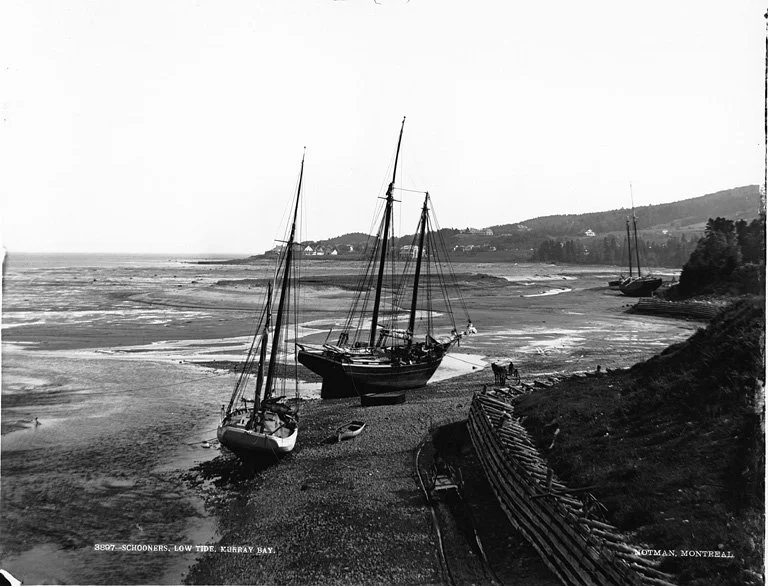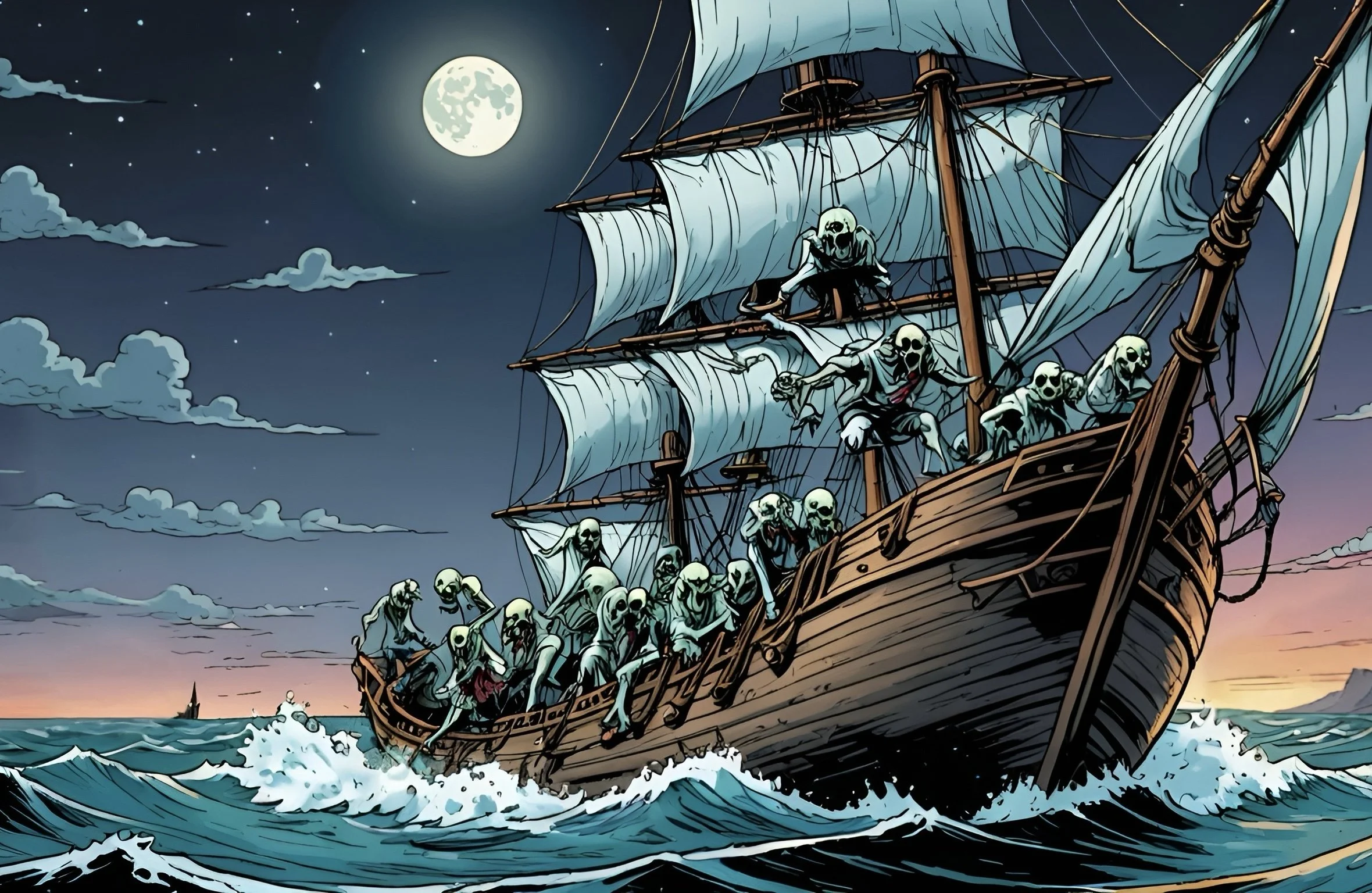The Charles Haskell and The Ghostly Fishermen
The Charles Haskell was a New England fishing schooner — designed to survive the unforgiving waters of the North Atlantic. Despite her solid construction, her fishing career was short-lived. They say she ended her days hauling cargo in Nova Scotia, but the Charles Haskell is remembered for something else entirely — a deadly accident, and a story of drowned men that wouldn’t stay dead.
They say the Charles Haskell is, perhaps, the most haunted ship ever to sail the North Atlantic.
And it all began with a storm…
The Storm
It was March 6, 1869.
The Charles Haskell, under the command of Captain Clifford Curtis, was fishing George’s Bank alongside more than a hundred other schooners when the weather turned. What began as a rough sea quickly descended into the kind of storm few had ever seen.
The captain, a seasoned mariner, knew things were about to get dangerous. He ordered everything on deck secured and dropped the anchor. They were going to try to hold their position.
By 11 p.m. the wind was howling, tearing across the deck. Hail and snow pelted the crew, work was treacherous. Two men were set on watch — one with an axe in hand, ready to cut the anchor if the storm brought another vessel too close.
All around them, the lights of oil lamps from other ships danced in the storm as waves tossed schooners high and low.
Soon, what everyone feared came to pass.
Schooners all around broke free of their moorings and ships careened through the darkness.
Out of nowhere, a vessel riding high on a wave was bearing down on the Haskell. In seconds it would be thrown atop them. Just as the captain had instructed, the watchman slammed his axe against the anchor ropes. The Haskell, broke free of her mooring, and was tossed out of the path of the oncoming ship.
It was a near miracle, they had escaped collision — but now there was a new problem, the Haskell herself was adrift.
Captain Curtis lashed himself to the wheel. Controlling the ship was nearly impossible — the sea was too strong and the storm was blinding. All around them in the darkness were ships. The crew scanned the night.
When the warning came, little could be done.
Another schooner, the Andrew Jackson was dead ahead. No matter how the captain pulled the wheel, he couldn’t change course. The Haskell was on a direct course.
Out of nowhere, a swell lifted her, holding her high on the crest. The Andrew Jackson dipped and rolled into the trough.
Then, as if in slow motion, it happened.
The entire weight of the Haskell slammed into the Jackson, her keel ripping into the deck. Wooden planks twisted and tore, beams snapped, and water poured below deck. The Jackson was mortally wounded, but somehow the Haskell had survived.
The momentum of the wave carried them free of the wreck.
The crew of the Haskell stared in horror as the Jackson capsized in front of them. They watched as the desperate crew climbed onto the sinking hull, trying — and failing — to hold on against the power of the storm.
In seconds they were gone — all of them washed away.
On the Haskell, the damage was severe. Her bowsprit, jib, and mainsail were wrecked. The deck had been stripped clean and her dories washed away.
But somehow they’d managed to stay afloat.
Coming Ashore
When the sun rose over the Banks, the scope of the devastation became apparent. Ships all around were damaged, or worse.
For the Charles Haskell, the fishing trip was over. As battered as the Haskell was the toll on the crew was worse. Their ship — the very one that had kept them alive through the storm — had been responsible for drowning the crew of the Andrew Jackson. They were changed men.
It had been a horrible accident.
Thought there was nothing they could have done to prevent it, the guilt was overwhelming and it seemed to grow worse with every breath.
The Haskell began her slow limp to port. Some say she came to St. John’s, others to New England. Regardless, she was patched up — and by the next spring, she was back on the Banks.
That’s when the tragedy turned to terror.
Back on the Banks
Roughly a week into the voyage, the Charles Haskell was at anchor, not far from the site of the terrible storm. But this was a very different night — the sea was perfectly calm.
It was a beautiful evening. The watchman leaned on the rail, listening to the slow creak of the rigging and the gentle lap of water against the hull.
The moon illuminated the water, and off the starboard side he could see something moving in the water. It was hard to say what it was — it didn’t look like any poppies or fish he’d ever seen.
He raised the watchglass to his eye.
To his horror, the motion snapped into clear focus.
It was men, or the remains of them.
All around the Charles Haskell decaying bodies seemed to be rising from the depths, their heads breaking the surface.
In the moonlight, their pale, torn skin seemed to glow.
Slowly they seemed to turn, orienting themselves until some two dozen corpses fixed their cloudy eyes on the Haskell.
They began to move toward the vessel.
Three times, the watchman tried to call for the crew, and three times the words caught in his throat.
All the while, the corpses drew closer.
By the time he raised the alarm, the corpses were nearly at the boat.
Then, from the waterline came a sound — a slow, wet scrape. It was the sound of bone on wood as the dead men began a slow climb up the side of the schooner.
One by one, the figures hauled themselves over the rails — they were covered in torn oilskins and seaweed. Water poured from their bodies and pooled on the deck.
Whatever these corpses were now, it was clear that once upon a time, they had been Banks fishermen — and in death, they had not forgotten their trade.
They took positions at the rail, each one returning to a task he’d done in life. They baited hooks, set lines, and all through the night pantomimed the motions of hauling catch from the sea.
The crew of the Haskell huddled together, their hearts racing. There was no earthly explanation for what they were seeing — for what was happening before them.
The ghostly sailors didn’t seem to notice, or care about, the living crew. They went on with their work until just before dawn, when they slipped over the side of the Haskell, and sank beneath the waves.
As the sun rose, no one wanted to speak of what they’d seen. But every man aboard thought of the Andrew Jackson, and the men who’d drowned near that very spot, just a season ago.
A Funeral March
As the sun sank below the horizon, the crew grew uneasy. Thoughts of the ghostly fisherman, pushed any thought of sleep from their minds.
Then around midnight, the call rang out again: movement to starboard.
Just as before, the dead men rose and boarded the boat, And all through the night they fished, hauling their ghostly lines over the rails.
When the pale light of dawn broke, the ghostly crew stopped their work and turned in unison, their eyes fixed on the western horizon. One by one, they climbed over the rail, down the side of the boat, and out onto the water.
The waves held them as they began to walk — with the slow, solemn rhythm of a funeral march.
The crew of the Haskell watched as the spectral procession faded into daylight.
The master gave the order without discussion — the anchor was raised, and they left the Banks that very hour, the ghostly figures burned into their memories.
Never Again
Haunted by what they had witnessed, the crew refused to set foot on the Haskell again.
Over and over, new recruits doubted the superstitions but returned to shore believers. Eventually, the ship was left idle.
James Gillespie of Fortune Harbour, Notre Dame Bay remembered seeing the Haskell moored and abandoned in St. John’s Harbour:
"They hove the sails off her and let her rot at the wharf in St. John’s Harbour, because they could never get a crew to sign on her, after the trip when the spirits was seen."
They say she was sold to a man in Digby, Nova Scotia, and spent her remaining days as a cargo ship.
But her haunted voyages to the fishing banks were never completely forgotten.
Almost to the Last
In December 1920, the last surviving member of the Charles Haskell’s fishing crew died at the age of 82. According to newspaper reports, John Winters repeated the tale of his ghostly encounter on the Banks “almost to the last.”
A Story Set To Song
The story of the haunting of the Charles Haskell outlived any of her crew and spread far and wide.
"I have believed in spirits from that day unto this."
It inspired The Ghostly Sailors — a popular folk song up and down the east coast of North America, with multiple versions (under varying titles) collected in New England, Nova Scotia, and Newfoundland.
Elisabeth Greenleaf recorded a version in Newfoundland and published it in Ballads and Sea Songs of Newfoundland under the title Spirit Song of George’s Bank.
The Folk Songs of Atlantic Canada from the collections of MacEdward Leach contains four variants (under the title The Ghostly Fisherman) collected from Newfoundland and Labrador, available as audio recordings.
Below is a rendition by Alan Mills, based on a variant collected in the Canadian Maritimes.
Fact And Fiction
How much of the legend is true?
Maine Farmer, March 20, 1869
Well, according to newspapers of the day, there was a schooner called the Charles Haskell that reportedly collided with an unknown vessel on George’s Bank in March 1869.
By 1892, a vessel built in Massachusetts in 1869 called Charles Haskell, was sailing from Digby, Nova Scotia, under the ownership of John Wooster Snow.
In subsequent years, it appears she was still used for fishing, in some capacity.
Beyond that, little is clear.
Many who tell this story suggest the Haskell spent time in St. John’s, but little evidence backs that up (beyond the assertion of James Gillespie mentioned above.)
The song The Ghostly Sailors does seem to have been relatively well known in Newfoundland and Labrador, and in most versions, the narrator mentions his time fishing herring off the Newfoundland coast.
As for the ghostly fishermen — were they real?
I’ll leave that to you to decide.
The Charles Haskell on the Strange Truths and Tall Tales Podcast
-
A Night of Terror on the Banks, The Evening Telegram, April 2, 1884
Maine Farmer, March 20, 1869
The Ghosts of the Banker Haskell, Evening Herald, March 22, 1905
Ghosts of the Charles Haskell, Weird Massachusetts, 2008
The Curse of the Charles Haskell, Trapped Beneath The Ice!, Ted Pendersen, 1996
The Charles Haskell, Mysterious Canada, J. R. Colombo, 1988
Memorials, Folklore of the Sea, Margaret Baker, 1979
Shall I Sing You A Ghost Story, Richard A Blake, 2020
The Strange Voyage of the Charles Haskell, Strange New England.
Charles Haskell, Mercantile Navy List, 1911
I’ve Always Believed in Spirits…, Janet McNaughton, Culture and Tradition, vol. 6, 1982
Ballads and Sea Songs of Newfoundland, Elisabeth Greenleaf, 1968
Songs of the Maritimes, Folkways Records
Was The Last of the Haskell’s Crew, St. John’s Daily Star, December 16, 1920


